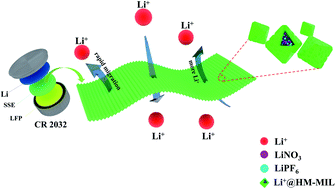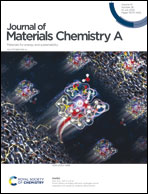A novel lithium-impregnated hollow MOF-based electrolyte realizing an optimum balance between ionic conductivity and the transference number in solid-like batteries†
Abstract
Low Li-ionic conductivity of solid electrolytes and an unstable interface contact severely hamper the practicability of lithium-ion solid-state batteries. It is always a great challenge to construct a well-behaved lithium electrolyte material with high electrochemical characteristics. Herein, a novel hollow structure HM-MIL with a large cavity has been prepared through selective surface corrosion of Cr, Al-bimetallic MIL-101, presenting an ionic conductivity of 6.53 × 10−4 S cm−1. Then, the electrochemical performance has been further optimized to obtain LiNO3@HM-MIL electrolyte based on LiNO3-filled HM-MIL. Encouragingly, LiNO3@HM-MIL presents good electrode/electrolyte interfacial compatibility, low interfacial resistances, stable Li plating/stripping and suppressed lithium dendrite growth. Moreover, the ionic conductivity was upgraded to 1.24 × 10−3 S cm−1 and the transference number was determined to be 0.86 for LiNO3@HM-MIL, which makes an optimal balance between these two important parameters up to now. Importantly, LiNO3@HM-MIL can be reused for 4000 h without obvious change in coulombic efficiency (100%), revealing good rate charge/discharge capability and long cycling durability. This study provides a new avenue for designing and fabricating high-performance lithium-ion batteries.



 Please wait while we load your content...
Please wait while we load your content...